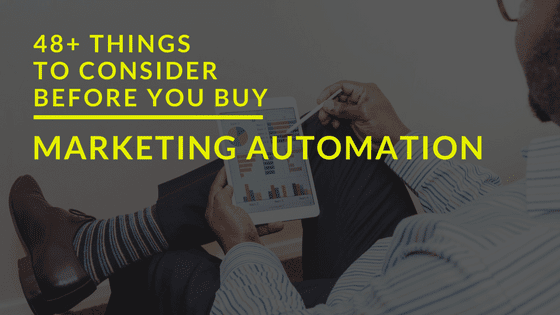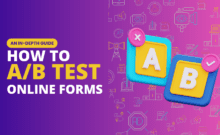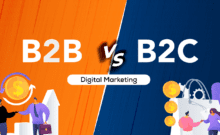48+ Things To Consider Before You Buy Marketing Automation Software
Marketing Automation software is becoming more and more prevalent in many businesses in 2021. Even more so, they are thinking of taking the plunge and investing. Tracking and identifying a return on investment on your marketing efforts is improving, yet many companies are not turning these metrics into meaningful, actionable insight. That is because most entrepreneurs accumulate data without considering each department’s data-tracking needs. Picking the right marketing automation software platform can feel overwhelming.
Here are a few key points to ponder during your evaluation. We have also devised a very handy Marketing Automation Vendor Comparison list for you to download and take away. There is a link to it at the bottom of this blog.
1. Establish your goals or objectives for the purchase
2. Are you looking to drive better alignment between sales and marketing?
3. Do you need to improve the quality of leads you’re currently getting?
4. Are you looking to drive better conversions and revenue?
5. Are the key features included?
Don’t pay more for features you aren’t going to use. Know what you really need, and make sure the platform you select delivers on those. Understand what you are trying to achieve/improve in your business, how this is going to be measured, and then choose the right tools and features to support that.
6. What does your marketing funnel look like?
Overextended entrepreneurs often overlook this vital phase, but your sales funnel is full of valuable information and content ideas. Before you take another step, slow down and ask yourself these important questions: Who are we speaking to? What information do they need? Are we going to measure their interest and response?
7. Test the platforms against a real-world marketing scenario.
8. Develop one or two marketing plays that you execute on each platform. The sales teams of each vendor will highlight all of their platform’s strengths but will underplay their weaknesses. Executing the test plays will quickly allow you to see where each platform has strengths and weaknesses.
9. If there are areas where the platforms are underperforming or lack a specific capability, establish if that capability will be available in the future.
10. Key Features that are a MUST have. The marketing automation solution you choose should support:
11. Asset creation, such as email messages, landing pages, and online forms
12. Ready-made templates you can use right out of the box
13. Easy, minimal-click campaign creation, management, and scheduling
14. Website visitor tracking and alerting so you can monitor results and target based on behaviours
15. Integration with other systems such as CRM, Google AdWords, webinar platforms, and social platforms
16. Lead generation, lead scoring, and lead management capabilities
17. Automated programs for lead nurturing, trigger email campaigns, etc.
18. Campaign tracking, analytics, and reporting that aligns with what is important to you and your clients
19. How long is the contract?
Ask if you have to sign a quarterly, annual, or other long-term contracts. You should be able to cancel at any point if you don’t feel the platform is the right fit for your business. The best planning in the world will never truly prepare you for the reality of using a large and expensive piece of software.
20. What are the payment terms?
You shouldn’t have to take out a mortgage to get started. Some vendors require full payment upfront – tying up valuable marketing dollars that could otherwise be spent on execution. So, look for a provider that offers month-to-month billing and no long-term contract.
21. Are you looking at both the price and the total cost of ownership?
Don’t be enticed by lower tiers that limit functionality. You’ll want the full power of marketing automation once you get started, and third-party add-ons for specific features add to the total cost. Also, pay attention to the limits. If a lower-tier has limits on contacts and sending, think of how often you’ll have overages, especially if your business is in a growth phase.
22. What’s the word on the street?
There are several great sites where you can go to hear what actual users are saying about the various platforms on the market. These independent review sites, like TrustRadius, MarTech and others, allow you to get insights that professional reviewers just don’t have. We actually put together a 2021 summary of one of these reviews here. Click here for a Marketing Automation Vendor Comparison.
23. Is it an “open” or “closed” platform?
An open system allows you to use any CRM, content management system, blogging tool, landing page builder, forms builder, etc. Be wary of a closed system – it can cost you more in the long run – especially if you decide to leave.
24. Complete an Online Demo
Every marketing automation platform will have a different user experience. Even if the software has the features you’re looking for, it will not enhance your marketing unless you can use them properly. Many of these marketing automation software companies offer a free online demo to take you through the unique interface and processes of their marketing automation software.
Perform one of these for each of the platforms on your shortlist. Hopefully, this will allow you to narrow your list down to one or two. Then you can complete a free trial, which often lasts a couple of weeks. This will help you to determine if each tool lives up to your needs and expectations.
25. Don’t overcomplicate it
New tools and strategies can be exciting and overwhelming. Do you want to add more fields because more data is always better, right? Not necessarily. Too much data can create scope creep and detract from the meaning behind the numbers. Boil your tracking needs down to the essentials. Keep it simple, and your team members can more easily identify the value behind your metrics.
26. Be honest about the Pros and Cons of B2B Marketing Automation Software
Regardless of your company’s size and marketing sophistication, marketing automation tools can provide the following benefits to the organisation:
27. Increased marketing efficiency
28. Enhanced ability to generate more and better-qualified leads
29. A multichannel view of prospect behaviour
30. Better alignment of sales and marketing goals
31. Improved lead conversion and ROI
Some of the challenges to be aware of with marketing automation include:
32. Complicated and time-consuming implementation and onboarding
33. Under-utilisation of platform features that lead to it only being used for email marketing
34. Sales and/or marketing resistance to changing marketing processes can impede platform adoption and efficiency
35. Are there integrations available to work with the tools you already use?
Look for a platform with its own ‘ecosystem’ of providers that it integrates with – either natively, through plug-and-play, or using a provider like Zapier or PieSync. This will allow you to seamlessly extend the power of your investment and lower the total cost of ownership.
36. Do the built-in analytics meet your business needs?
Choose a solution that provides clear, concise reports that show the end-to-end ROI you’re looking for in your marketing and sales efforts. Ask to see a sample and shop it around internally to make sure it’s going to be impactful.
37. Can you get up and running quickly?
Look at the interface. Is it user-friendly? Is there contextual help (e.g. videos, virtual tours, articles) available in case you get stuck? An intuitive platform will save you countless hours both upfront and long-term.
38. Is there quality support, both initially and ongoing?
Some providers hide fees here, so beware. Does the vendor provide comprehensive onboarding to give your team confidence in using the platform? If so, what’s the cost? Is ongoing support unlimited and free, or are there caps and additional costs? Also, ask if you’ll get a dedicated person you can call when support can’t help.
39. Should you work with an agency or manage this in-house?
While many platforms are user-friendly, there’s legwork involved in setting up a marketing automation program that produces results. Also, you need ongoing efforts to maintain and update your campaigns, add new ones, and produce regular reports. If you can’t allocate someone in-house to lead the charge, consider using a marketing agency specialising in these services. Ask the marketing automation vendor if they have a network of agency professionals that can help you achieve your goals.
40. What’s the long-term outlook for the platform?
There have been some notable acquisitions in the marketing automation space recently. Be sure you are signing up with a vendor that is committed to your long-term success and is investing in platform innovation, support, and other services.
41. Usability of the system
The most powerful marketing automation platforms in the world are completely worthless if your team doesn’t know how to use them properly. When shopping for the best solution, consider usability factors such as these:
42. Is the platform easy to learn and use?
43. Will the reporting features deliver the key metrics I need?
44. Does the provider offer technical support or implementation advice?
45. What kind of training is included?
46. How long will it take us to implement the platform?
47. Does the platform offer mobile access?
48. Can I restrict certain features and information within the platform by the user or job function?
Marketing automation software can take your marketing mix to the next level and help your sales department close more leads, but it’s important to pick one that works for your company’s unique needs, resources, and budget.
Simply put, marketing automation software can amplify the effectiveness of a marketing strategy that’s already working, but it can’t make an ineffective strategy work. Also, it won’t substitute for a lack of strategy!
What are your best tips for selecting marketing automation software? Share your thoughts or questions in the comments!
Check out our handy Marketing Automation Vendor Comparison Tool










Leave a Comment